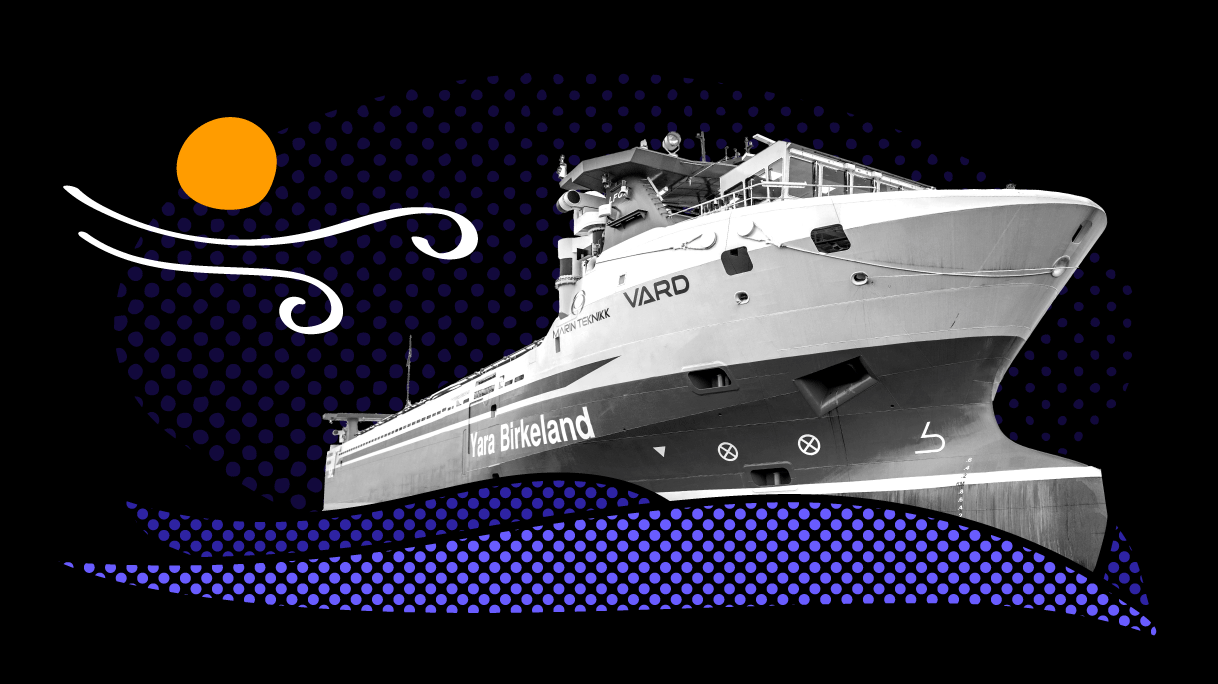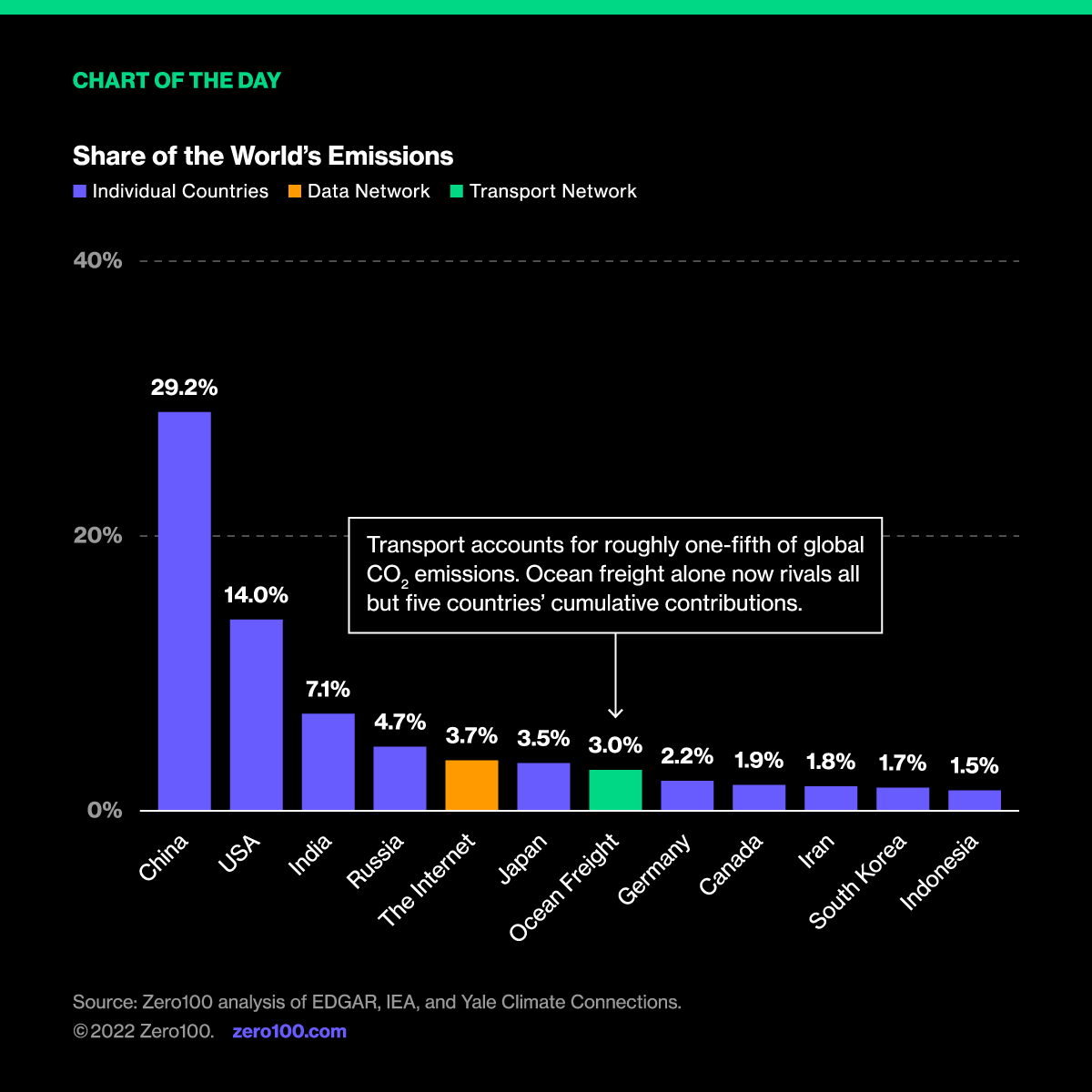
Whatever Floats Your Boat
A deep dive into recent announcements from major ocean freight players (including Hapag-Lloyd, DB Schenker, and Maersk) demonstrate broad innovation across container tracking, autonomous vessels, and new fuel sources. Investment in all three areas is increasing in anticipation of the first Energy Efficiency Ship Index (EEXI) and Carbon Intensity Indicator (CII) reports expected from the IMO in 2023.
Water Wars: Technology Edition
Most of the goods we move through our supply chains move over the water, cocooned in a difficult-to-find shipping container. The ocean freight industry is growing, as are related industries such as ocean freight forwarding (+7.7% CAGR), maritime safety (+6.9% CAGR), and weather forecasting (+9.9% CAGR). Today, about 90% of all goods moving through our global supply chains rely on ocean shipping, with maritime trade volumes expected to triple by 2050.
This past week, we saw several companies highlighting technology investments and innovations in this area – all designed to enhance transparency, reduce carbon, and improve the outlook of the industry. To accelerate the stated goals of the International Maritime Organization (-40% carbon intensity by 2030, -50% total emissions by 2050), regulatory frameworks for shipping will need to promote new fuel types for a new generation of cargo vessel – operating at scale.
In the race to achieve greater efficiency and sustainability, leaders in the ocean freight industry are engaged in a war of words anchored by three superlatives: Smartest, Sustainable, and Green.
World's “Smartest” Container Fleet
The largest member of the Transport High Efficiency (THE) Alliance, Hapag-Lloyd announced a $250M investment in real-time tracking technology, aimed to further woo customers toward its premium services (i.e., first-box-off, voyage-specific space). By end of year, tracking hardware from companies Nexxiot and Orbcomm will accompany nearly all dry containers across its 1.8M TEU fleet. As a result, customers will achieve “full visibility of any container movement worldwide,” explains Maximilian Rothkopf (COO, Hapag-Lloyd), allowing the ultimate consignee to better anticipate and mitigate growing port disruptions.
“It is our vision to build the world's smartest container fleet and to provide valuable information to our customers at the frequency they need”
Olaf Habert, Director of Container Applications, Hapag-Lloyd
Transparency into container location remains a critical building block for modeling real-time carbon flows. In terms of practical application, project44's supply chain visibility platform already utilizes real-time freight movement to enable customers to graduate from carbon estimates to actual modeling data, unlocking superior optimization and real-time decision making. In combination, the data from trackers adopted by Hapag-Lloyd and analysis provided by project44 can feed into models that determine which lanes and conditions offer optimal performance against carbon reduction targets.
World's Leading “Sustainable” Manufacturer
DB Schenker also has their sights set on zero-emission, fully-electric, fully-autonomous seafaring vessels. Their “first of its kind” prototype was created in partnership with Ekornes ASA in Norway, Naval Dynamics, Massterly, and Kongsberg.
Ekornes plans to leverage this partnership with DB Schenker by demonstrating how an electric, autonomous logistics solutions can substantially improve their visibility and control over Scope-3 emissions – advancing their claim as the world's leading manufacturer of sustainable, premium furniture.
“We will meet our sustainability targets by using the most innovative technology available... we will also gain better control over, and greater flexibility with, our own logistics.”
Roger Lunde, CEO, Ekornes AS
The opportunity here goes beyond reducing the carbon direct from ocean freight to the wider transportation network. Models of the Yara Birkeland (the first autonomous, zero-emission cargo container) and its ability to recharge batteries quayside demonstrate the potential to remove up to 40,000 truck journeys a year required to refuel traditional, diesel-powered cargo vessels.
World's Largest Purchaser of “Green" Hydrogen
The final superlative today comes from AP Moller-Maersk, which recently ordered 12 methanol-fueled container vessels from Hyundai. This purchase indicates the real possibility that Maersk could soon emerge as the world's largest consumer of “green" hydrogen.
Green hydrogen is emissions-free, thanks to the production process used to create it which splits water into hydrogen and oxygen using electric from renewable energy.
“We are very excited about this addition to our fleet, which will offer our customers unique access to carbon neutral transport”
Henriette Hallberg Thygesen, CEO of Fleet & Strategic Brands, A.P. Moller – Maersk
But the aspiration of green hydrogen is a difficult one, as Maersk faces a supply shortage for their growing fleet. The underlying challenge has already forced further innovation, including a new partnership and investment with WasteFuel, designed to solve both the waste crisis and the growing need for low-carbon fuels.
Bio-methanol feedstock created from waste streams present a compelling financial option, as some companies will pay to have their waste removed. At present, the trade association Methanol Institute expects two million tons of bio-methanol and e-methanol to be available by 2030.
Superlatives for Partnership
Setting the goal of becoming the world's best is often the benchmark we need to pursue the innovations that pave the path for the entire industry. Getting there will take investing in visibility, upgraded hardware and software, and alternative fuel sources. These investments can be accelerated with the growing “water war” competition – and its extension to other industries.

Critical Reading
THE ATLANTIC
What's Behind America's Shocking Baby-Formula Shortage?
Commentary: Excellent root cause analysis and lessons learned from the nationwide shortage of baby-formula impacting the United States, where 40% of formula is currently out-of-stock at major retailers, including Walgreens, CVS, and Target.
#recall #FDA
THE NEW YORK TIMES
Oil Giants Sell Dirty Wells to Buyers with Looser Climate Goals, Study Finds
Commentary: New research from the Environmental Defense Fund highlights the complexity of progressing against ESG goals (on paper) versus transferring liabilities through asset divestment to new (and less responsible) operators.
#oil #ESG
BUSINESS FOR SOCIAL RESPONSIBILITY
Key Ways for Business to Prepare for the Fall of Roe v. Wade
Commentary: Comprehensive primer on potential economic losses, complication to workforce mobility, and impact on corporate social responsibility programs stemming from the leaked draft majority opinion reversing Roe v. Wade – including seven key actions for business leaders to proactively consider.
#SCOTUS #DEI